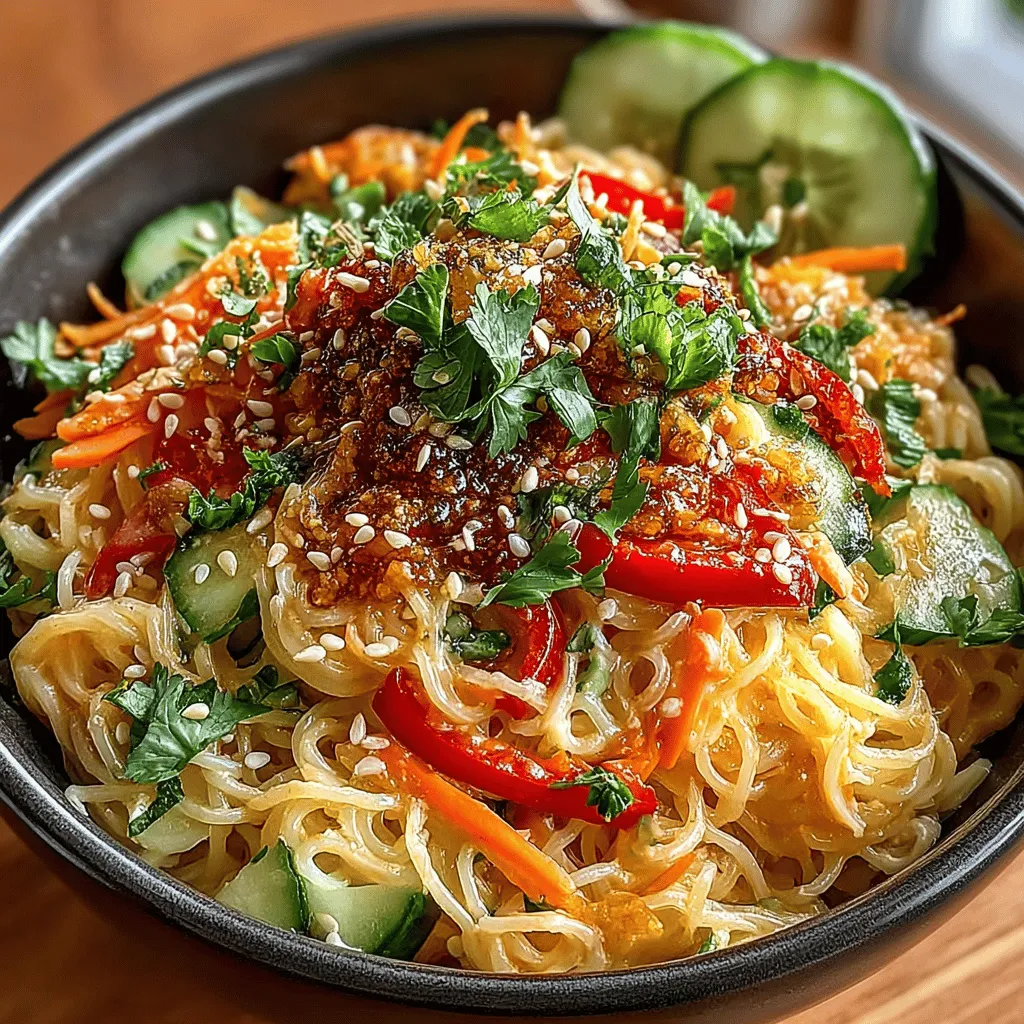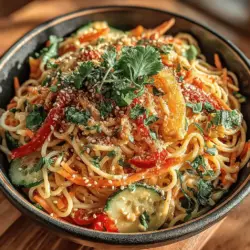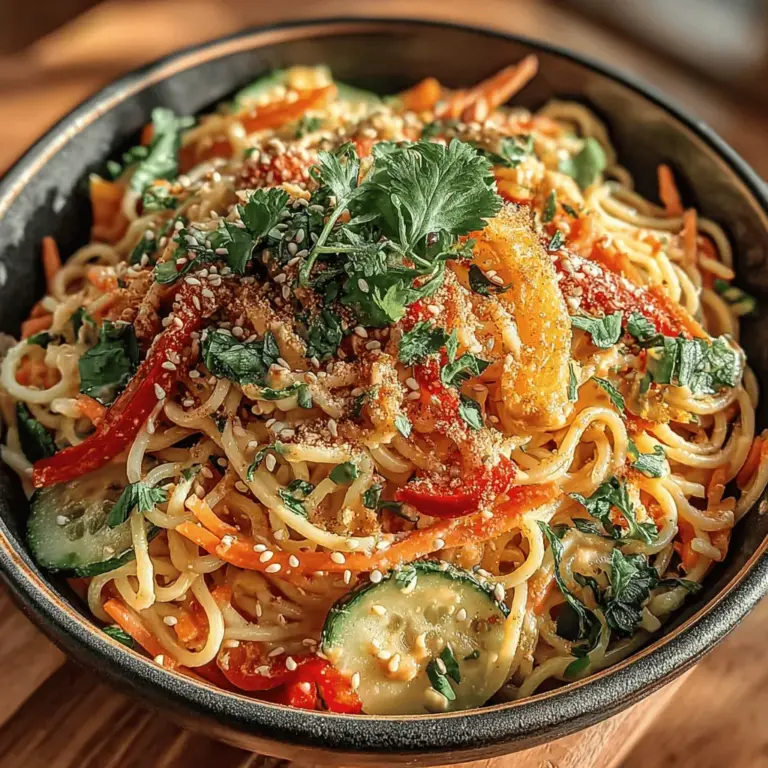Chill & Thrill: Cold Peanut Sesame Noodles Recipe
Introduction
Cold noodle dishes have long been a cherished staple in cuisines around the world, celebrated for their refreshing qualities and versatility. From the tangy, chilled soba noodles of Japan to the vibrant vermicelli bowls found throughout Southeast Asia, these dishes offer a delightful respite from the heat, making them a perfect choice for warm weather dining. Among the myriad of flavors and presentations, cold peanut sesame noodles stand out as a beloved favorite, combining the rich, nutty essence of peanut sauce with the satisfying chew of noodles. This recipe not only showcases the vibrant flavors and textures of Asian cuisine but also highlights the ease of preparation, making it an ideal option for quick meals, summer gatherings, or light lunches.
Peanut sauce, a staple in many Asian dishes, is celebrated for its creamy texture and complex flavor profile that balances sweet, salty, and spicy notes. The combination of cold noodles with this luscious sauce creates a dish that is both comforting and invigorating. Whether you’re looking for a quick weeknight dinner or a dish to impress at your next potluck, cold peanut sesame noodles provide a delightful and accessible culinary experience.
Understanding Cold Peanut Sesame Noodles
The cultural significance of cold noodle dishes is deeply rooted in Asian culinary traditions. In countries like China, Korea, and Japan, chilled noodles are often enjoyed during the hot summer months, providing a quick and refreshing meal option. These dishes are not only satisfying but also versatile, allowing for a variety of ingredients and flavors to be incorporated based on regional preferences and seasonal availability.
Central to the appeal of cold peanut sesame noodles is the peanut sauce, which serves as both a dressing and a flavor enhancer. Peanut sauce typically blends creamy peanut butter with essential ingredients such as soy sauce, sesame oil, and sweeteners, resulting in a well-rounded sauce that complements the noodles and vegetables perfectly. The magic lies in the balance of flavors—creamy from the peanut butter, salty from the soy sauce, sweet from honey or maple syrup, and a hint of spice that can be adjusted to taste. This harmony transforms the dish into a delightful experience for the palate, where each bite is a burst of flavor.
Ingredients Breakdown
To create a truly memorable bowl of cold peanut sesame noodles, it’s essential to understand the role of each ingredient. Here’s a closer look at what goes into this dish, highlighting their flavor profiles and nutritional benefits.
– Noodles: The foundation of any noodle dish, the choice of noodles can significantly alter the overall experience. While traditional recipes often call for wheat-based noodles, such as spaghetti or soba, rice noodles are a popular gluten-free alternative that provides a light and chewy texture. Rice noodles are particularly great for soaking up the peanut sauce, making them an excellent choice for this recipe. Regardless of your choice, the noodles should be cooked until al dente and then rinsed under cold water to stop the cooking process, ensuring a refreshing bite.
– Peanut Butter: The star of the show, peanut butter brings both creaminess and a rich, nutty flavor to the dish. When selecting peanut butter, you can opt for creamy or chunky varieties depending on your preference. Creamy peanut butter lends a smooth texture to the sauce, while chunky peanut butter adds delightful bits of peanuts that enhance the dish’s crunch. Nutritionally, peanut butter is a great source of protein and healthy fats, making it a satisfying addition to your meal.
– Sauces and Oils: Soy sauce and sesame oil are two essential components of the peanut sauce that contribute to its depth of flavor. Soy sauce adds a savory umami element, while sesame oil introduces a subtle nuttiness that complements the peanut butter. It’s worth noting that low-sodium soy sauce options are available for those watching their salt intake. Additionally, sesame oil is rich in antioxidants and healthy fats, making it a heart-healthy choice when used in moderation.
– Sweeteners: The balance of flavors in peanut sauce often includes a sweetener to counteract the saltiness of the soy sauce. Honey and maple syrup are two popular options, each providing a distinct flavor profile. Honey has a floral sweetness that can enhance the dish, while maple syrup offers a unique, earthy flavor. For those with dietary restrictions, maple syrup is a suitable vegan alternative that can still achieve the desired sweetness.
– Vegetables: Adding fresh vegetables to the dish not only boosts its nutritional value but also enhances its texture and flavor. Carrots, cucumbers, and bell peppers are commonly used in cold peanut sesame noodles, providing a delightful crunch and vibrant color. Carrots are rich in beta-carotene and antioxidants, while cucumbers are hydrating and low in calories, making them an excellent addition for a refreshing dish. Bell peppers contribute a sweet crunch and are packed with vitamin C, supporting overall health.
– Garnishes: Finally, garnishes such as cilantro and mint elevate the dish’s presentation and flavor. These herbs provide a fresh burst of taste that complements the richness of the peanut sauce. Cilantro adds a slightly citrusy note, while mint brings a cooling effect, making each bite more enjoyable. Additionally, garnishes can enhance visual appeal, turning your cold peanut sesame noodles into an eye-catching dish that’s perfect for sharing.
As you prepare to embark on making your own cold peanut sesame noodles, gather these ingredients and prepare for a culinary adventure that promises to be both satisfying and refreshing. The following sections will guide you through the step-by-step process of assembling this delightful dish, ensuring that you can enjoy the perfect balance of flavors and textures in every bite.

Step-by-Step Preparation Guide
Creating Cold Peanut Sesame Noodles is an enjoyable culinary journey that results in a refreshing, flavorful dish. Follow these comprehensive steps to perfect your noodle preparation and enhance your dish with delicious flavors.
Cooking the Noodles
Start by choosing the right noodles for this recipe. While traditional options include Chinese egg noodles or soba noodles, you can also use rice noodles for a gluten-free alternative. Here’s how to cook them perfectly:
1. Bring a Large Pot of Water to a Boil: Fill a pot with water and add a generous pinch of salt. Bring it to a rolling boil. The salt not only flavors the noodles but also helps them retain their texture.
2. Add the Noodles: Carefully add the noodles to the boiling water. Stir them gently to prevent sticking.
3. Cook Al Dente: Follow the package instructions for cooking time, but start checking for doneness about a minute before the recommended time. You want the noodles to be al dente—firm to the bite but not hard. Overcooked noodles can become mushy and negatively affect the dish.
4. Rinse Under Cold Water: Once cooked, drain the noodles in a colander and immediately rinse them under cold running water. This step stops the cooking process and helps to remove excess starch, which prevents the noodles from clumping together later on.
Making the Peanut Sauce
The peanut sauce is the star of this dish, providing rich flavors that complement the noodles beautifully. Here’s how to make it:
1. Gather Your Ingredients: You’ll need smooth peanut butter, soy sauce, rice vinegar, sesame oil, garlic, and a touch of honey or maple syrup for sweetness. You may also want to include chili paste for a spicy kick.
2. Mix the Ingredients: In a medium bowl, combine:
– 1/2 cup smooth peanut butter
– 2 tablespoons soy sauce
– 1 tablespoon rice vinegar
– 1 tablespoon sesame oil
– 1 clove of minced garlic
– 1 tablespoon honey or maple syrup
– Optional: 1 teaspoon chili paste for heat.
3. Whisk Until Smooth: Use a whisk to blend the ingredients until the sauce achieves a creamy, pourable consistency. If the sauce is too thick, add a little warm water, one tablespoon at a time, until you reach the desired consistency.
4. Taste and Adjust: This is where you can customize your sauce. Taste and adjust the flavors by adding more soy sauce for saltiness, more vinegar for acidity, or more sweetener to balance the flavors.
Combining Ingredients
Now it’s time to bring everything together for maximum flavor distribution:
1. In a Large Bowl: Place the rinsed noodles into a large mixing bowl.
2. Add Vegetables: Incorporate your choice of vegetables. Common additions include julienned carrots, sliced bell peppers, and shredded cabbage. These not only add color but also crunch and nutrition.
3. Pour the Peanut Sauce: Drizzle the prepared peanut sauce over the noodle and vegetable mixture.
4. Toss to Combine: Use tongs or two forks to gently toss everything together. Ensure that the noodles are well-coated in the sauce and that the vegetables are evenly distributed throughout.
Chilling the Dish
Chilling your Cold Peanut Sesame Noodles is essential for enhancing the flavors, allowing them to meld beautifully:
1. Refrigerate: Once combined, cover the bowl with plastic wrap or transfer the noodles to an airtight container. Refrigerate for at least 30 minutes to 1 hour. This chilling time allows the flavors to deepen and the dish to become refreshing.
Serving Suggestions
Presentation is key when serving this delightful dish:
1. Plate the Noodles: Use tongs to twirl a serving of the chilled noodles into a nest shape on a plate.
2. Garnish: Consider garnishing with chopped green onions, sesame seeds, or fresh cilantro for a pop of color and additional flavor.
3. Serve Cold: The Cold Peanut Sesame Noodles are best served cold, making them a perfect dish for hot summer days or as a make-ahead meal for picnics and potlucks.
Nutritional Analysis
Cold Peanut Sesame Noodles are not only delicious but also nutritious. Here’s a breakdown of the nutritional content per serving (approximately one cup):
– Calories: 350
– Protein: 12g
– Fats: 18g (includes healthy fats from peanut butter and sesame oil)
– Carbohydrates: 38g
– Fiber: 4g
– Vitamins: A source of vitamins A and C from the vegetables.
This dish is suitable for various dietary lifestyles:
– Vegetarian and Vegan: With plant-based ingredients, this recipe is perfect for anyone following a vegetarian or vegan diet.
– Gluten-Free: By using rice noodles or gluten-free soy sauce, this dish can easily be made gluten-free.
Flavor Variations and Additions
The versatility of Cold Peanut Sesame Noodles allows for endless variations. Here are some suggestions to customize your dish:
1. Protein Additions: Enhance the nutritional value by adding proteins such as:
– Tofu: Marinated and grilled or pan-fried tofu complements the dish well.
– Chicken: Grilled or shredded chicken can be added for a heartier meal.
– Shrimp: Cooked shrimp provides an elegant touch, especially for gatherings.
2. Seasonal Vegetables: Feel free to swap in seasonal vegetables based on availability:
– Cucumbers: For a refreshing crunch in summer.
– Zucchini: Lightly sautéed or raw, adds a mild flavor.
– Snap Peas: For a sweet, crisp bite.
3. Alternative Sauces: Try different sauces to create unique flavor profiles:
– Spicy Szechuan Sauce: For a kick, swap the peanut sauce with a Szechuan-inspired sauce.
– Coconut Aminos: For a soy-free option, use coconut aminos instead of soy sauce.
– Cilantro-Lime Dressing: Brighten the dish with a zesty alternative.
Conclusion
Cold Peanut Sesame Noodles are an appealing and versatile dish that can be enjoyed in a multitude of settings, from casual lunches to elegant dinners. The combination of chewy noodles, crunchy vegetables, and a rich, creamy peanut sauce creates a delightful experience for the palate.
As you prepare this dish, feel free to experiment with different ingredients and flavors to make it truly your own. The recipe encourages creativity, allowing you to explore new combinations while enhancing your culinary repertoire. Whether you serve it at a summer gathering or enjoy it as a quick weeknight meal, Cold Peanut Sesame Noodles are sure to please. Dive into this delightful dish today and discover the joy of making it part of your regular meal rotation!

